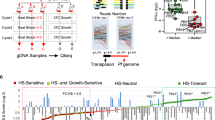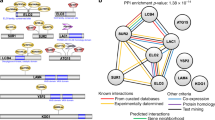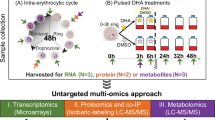Abstract
Parasites of the phylum Apicomplexa cause substantial morbidity, mortality and economic losses, and new medicines to treat them are needed urgently1,2. The shikimate pathway is an attractive target for herbicides and antimicrobial agents because it is essential in algae, higher plants, bacteria and fungi, but absent from mammals3,4. Here we present biochemical, genetic and chemotherapeutic evidence for the presence of enzymes of the shikimate pathway in apicomplexan parasites. In vitro growth of Toxoplasma gondii, Plasmodium falciparum (malaria) and Cryptosporidium parvum was inhibited by the herbicide glyphosate, a well-characterized inhibitor3 of the shikimate pathway enzyme 5-enolpyruvyl shikimate 3-phosphate synthase. This effect on T. gondii and P. falciparum was reversed by treatment with p-aminobenzoate, which suggests that the shikimate pathway supplies folate precursors for their growth. Glyphosate in combination with pyrimethamine limited T. gondii infection in mice. Four shikimate pathway enzymes were detected in extracts of T. gondii and glyphosate inhibited 5-enolpyruvyl shikimate 3-phosphate synthase activity. Genes encoding chorismate synthase, the final shikimate pathway enzyme, were cloned from T. gondii and P. falciparum. This discovery of a functional shikimate pathway in apicomplexan parasites provides several targets for the development of new antiparasite agents.
This is a preview of subscription content, access via your institution
Access options
Subscribe to this journal
Receive 51 print issues and online access
$199.00 per year
only $3.90 per issue
Buy this article
- Purchase on Springer Link
- Instant access to full article PDF
Prices may be subject to local taxes which are calculated during checkout



Similar content being viewed by others
References
Fichera, M. E. & Roos, D. S. Aplastid organelle as a drug target in apicomplexan parasites. Nature 390, 407–409 (1997).
McFadden, G. I., Keith, M. E., Monholland, J. M. & Lang-Unasch, N. Plastids in human parasites. Nature 381, 482 (1996).
Kishore, G. M. & Shah, D. M. Amino acid biosynthesis inhibitors as herbicides. Annu. Rev. Biochem. 57, 627–663 (1988).
Haslam, E. Shikimic Acid: Metabolism and Metabolites(John Wiley, Chichester, 1993).
Williamson, D. H. et al. The evolutionary origin of the 35kb circular DNA of Plasmodium falciparum: new evidence supports a possible rhodophyte ancestry. Mol. Gen. Genet. 243, 249–252 (1994).
Kohler, S. et al. Aplastid of probable green algal origin in apicomplexan parasites. Science 275, 1485–1489 (1997).
Hackstein, J. H. P., Mackenstedt, U., Melhorn, H., Schubert, H. & Leunissen, J. A. M. Parasitic apicomplexans harbor a chlorophyll a-D1 complex, the potential target for therapeutic triazines. Parasitol. Res. 81, 207–216 (1995).
Bentley, R. The shikimate pathway—a metabolic tree with many branches. Crit. Rev. Biochem. Mol. Biol. 25, 307–383 (1990).
Gorlach, J., Schmid, J. & Amrhein, N. Differential expression of tomato (Lycopersicon esculentum L.) genes encoding shikimate pathway isoenzymes. II. Chorismate synthase. Plant Mol. Biol. 23, 707–716 (1993).
Haucke, V. & Schatz, G. Import of proteins into motochondria and chloroplasts. Cell Biol. 7, 103–106 (1997).
Steinrucken, H. C. & Amrhein, N. The herbicide glyphosate is a potent inhibitor of 5-enolpyruvyl-shikimic acid 3-phosphate synthase. Biochem. Biophys. Res. Commun. 94, 1207–1212 (1980).
Coggins, J. R. et al. The arom multifunctional enzyme (Neurospora crassa). Methods Enzymol. 142, 325–335 (1987).
Ramjee, M. K., Coggins, J. R. & Thorneley, R. N. F. Acontinuous, anaerobic spectrophotometric assay for chorismate synthase activity that utilizes photoreduced flavin mononucleotide. Anal. Biochem. 220, 137–141 (1994).
Deka, R., Anton, I. A., Dunbar, B. & Coggins, J. R. The characterisation of the shikimate pathway enzyme dehydroquinase from Pisum sativum. FEBS Lett. 349, 397–402 (1994).
Mousdale, D. M. & Coggins, J. R. High performance liquid chromatography of shikimate pathway intermediates. J. Chromatogr. 329, 268–272 (1985).
Duggan, P., Parker, E., Coggins, J. & Abell, C. Enzymatic synthesis of (6R) and (6S)-fluoroshikimic acids. Bioorg. Med. Chem. Lett. 5, 2347–2352 (1995).
Dieckmann, A. & Jung, A. Mechanisms of sulfadoxine resistance in Plasmodium flaciparum. Mol. Biochem. Parasitol. 19, 143–147 (1986).
Marzabadi, M. R. et al. An EPSP synthase inhibitor joining shikimate-3-phosphate with glyphosate: synthesis and ligand binding studies. Biochemistry 35, 4199–4210 (1996).
Davies, G. M. et al. (6S)-6-fluoroshikimic acid, an antibacterial agent acting on the aromatic biosynthetic pathway. Antimicrob. Agents Chemother. 38, 403–406 (1994).
Banerji, S., Lugli, E. B., Miller, R. F. & Wakefield, A. E. Analysis of genetic diversity at the arom locus in isolates of Pneumocystis carinii. J. Euk. Microbiol. 42, 675–679 (1995).
Garbe, T. et al. The Mycobacterium tuberculosis shikimate pathway genes: Evolutionary relationship between biosynthetic and catabolic 3-dehydroquinases. Mol. Gen. Genet. 228, 385–392 (1991).
Mack, D. & McLeod, R. Anew micromethod to study effects of antimicrobial agents on Toxoplasma gondii: Comparison of sulfadoxine and sulfadiazine and study of clindamycin, metronidazole, and cyclosporin A. Antimicrob. Agents Chemother. 26, 26–30 (1984).
White, P. J., Millar, G. & Coggins, J. R. The overexpression, purification and complete amino acid sequence of chorismate synthase from Escherichia coli K12 and its comparison with the enzyme from Neurospora crassa. Biochem. J. 251, 313–322 (1988).
Schmidt, J., Bubunenko, M. & Subramanian, A. R. Anovel operon organization involving the genes for chorismate synthase (aromatic biosynthesis pathway) and ribosomal GTPase center proteins (L11, L1, L10, L12: rp1KAJL) in cyanobacterium Synechocystis PCC 6803. J. Biol. Chem. 268, 27447–27457 (1993).
Jones, D. G., Reusser, U. & Braus, G. H. Molecular cloning, characterization and analysis of the regulation of the aroC gene, encoding chorismate synthase, of Saccharomyces cerevisiae. Mol. Microbiol. 5, 2143–2152 (1991).
Fleischmann, R. D. et al. Whole-genome random sequencing and assembly of Haemophilus infleunzae Rd. Science 269, 496–512 (1995).
Henstrand, J., Amrhein, N. & Schmid, J. Cloning and characterization of a heterologously expressed bifunctional chorismate synthase/flavin reductase from Neurospora crassa. J. Biol. Chem. 270, 20447–20452 (1995).
Milhous, W. K., Weatherly, N. F., Bowdre, J. H. & Desjardins, R. E. In vitro activities and mechanisms of resistance to anti-folates and anti-malarial drugs. Antimicrob. Agents Chemother. 27, 525–530 (1985).
Oduola, A. M. J., Weatherly, N. F., Bowdre, J. H. & Desjardins, R. E. Plasmodium falciparum—cloning by single erythrocyte micromanipulation and heterogeneity in vitro. Exp. Parasitol. 66, 86–95 (1988).
Tzipori, S. Laboratory investigations and chemotherapy of Cryptosporidium parvum. Adv. Parasitol. 40, 188–221 (1998).
Acknowledgements
We thank L. Mets for information about plants; D. Sibley and the Toxoplasma EST Project at Washington University for the putative chorismate synthase EST; M. Gottlieb, J. Boothroyd, K. Kim, L. Weiss, A. Lapthorn, A. Martin, M. Rust and U. Gross for discussions; and V. Aitchison and E. Holfels for assistance in preparation of this manuscript. F.R. was a recipient of a Royal Pathological Society of Great Britain and Northern Ireland Travelling Fellowship, C.W.R. was a Fulbright Scholar, and a Michael Reese Physicians' Research and Education Foundation Postdoctoral Fellow and Visiting Scholar and is a Glaxo Jack Lecturer. R.M. is the Jules and Doris Stein Research to Prevent Blindness Professor at The University of Chicago. This work was supported by the NIH NIAID TMP program, the Toxoplasmosis Research Institute, the Research to Prevent Blindness Foundation, an NIH contract from NIH NIAID (the AIDS Opportunistic Infection Drug Discovery), and the WHO-NIH-WRAIR Drug Development Programs, The Wellcome Trust and the European Union.
Author information
Authors and Affiliations
Corresponding author
Rights and permissions
About this article
Cite this article
Roberts, F., Roberts, C., Johnson, J. et al. Evidence for the shikimate pathway in apicomplexan parasites. Nature 393, 801–805 (1998). https://doi.org/10.1038/31723
Received:
Accepted:
Issue Date:
DOI: https://doi.org/10.1038/31723
This article is cited by
-
Pangenome and subtractive genomic analysis of Clostridioides difficile reveals putative drug targets
Journal of Proteins and Proteomics (2022)
-
Building Programs to Eradicate Toxoplasmosis Part I: Introduction and Overview
Current Pediatrics Reports (2022)
-
Building Programs to Eradicate Toxoplasmosis Part IV: Understanding and Development of Public Health Strategies and Advances “Take a Village”
Current Pediatrics Reports (2022)
-
In vivo and in vitro evaluation of the effect of glyphosate (Roundup) on Toxoplasma gondii
Journal of Parasitic Diseases (2021)
-
Comparative epidemiology and pathophysiology of patent and latent babesiosis caused by Babesia bigemina in buffaloes and cattle from different agroclimatic zones of Punjab State, India
Tropical Animal Health and Production (2021)
Comments
By submitting a comment you agree to abide by our Terms and Community Guidelines. If you find something abusive or that does not comply with our terms or guidelines please flag it as inappropriate.



